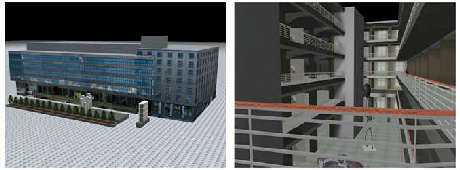by Stanislav Mikeš, Michal Haindl and Radek Holub
Scientists at Institute of Information Theory and Automation (UTIA), Academy of Sciences of the Czech Republic have developed a detailed virtual model of the Department of Modern Art of the National Gallery in Prague. This impressive seven-storey building holds the gallery’s collection of contemporary images, drawings and statues as well as several temporary exhibitions. This virtual model serves as a comprehensive 3D information system with navigation support for visitors and as an interactive tool for exhibition designers and curators. Within the comfort of their own home, visitors can experience an animated online thematic visit to their selected works of art and also print a map with a proposed personalized route.
While navigation in real world, ie travelling to a specific target location, often poses a challenging and only partially-understood problem, especially in unknown environment, navigation in a virtual reality (VR) environment is even more difficult due to many missing real world cues. A major problem for users of virtual environments is maintaining knowledge of their location and orientation while they move through the space because perceptual judgements are biased within a virtual environment.
The proposed solution for navigation in this huge gallery building, which has seven exhibition floors and two large exhibition halls in the ground floor, is based on the graph structure. One’s actual position in a complex virtual scene is depicted as a highlighted point in an overlaid transparent map of the building floor plan. This basic navigation graph structure is constructed semi-automatically and it is subsequently locally changed by the exhibition editor which places new exhibition panels into the building interior and thus locally changes the navigation route structure. The optimal navigation route is automatically generated using graph algorithms and user defined constraints. For example, we assume that a visitor will never walk closer than half a metre to the walls, will pass through each exit in its centre and larger spaces are covered with walking loops with a minimum diameter of one metre, etc. Each floor plan is than supplemented with a preset route graph structure based on the basic building structure. Single corridors, lifts and staircases are represented as graph edges, while doors, branching or turning points are graph vertices. This initial graph structure which represents initialization of navigation routes can be generated semi-automatically based on the floor plans. Narrow corridors have single graph edges while wider corridors or halls can have several graph loops. This automatically proposed graph structure (primary graph) can be interactively edited using the exhibition editor. Superfluous edges or vertices can be removed while new edges and vertices can be added. Single edges or vertices can also be shifted to other positions and vertices can be supplemented with additional attributes such as emergency exits, lifts, staircases and doors.

Figure 1: National Gallery in Prague virtual model.

Figure 2: Selected navigation frames (2,5,11,25 top, 27,32,38,42 bottom) around a virtual exhibition.
The virtual National Gallery model allows virtual exhibitions to be built interactively using our exhibition editor. The editor was devised for exhibition architects to support and speed up their exhibitions proposals. The editor loads a requested floor plan and allows insertion of single exhibition panels and specification of their parameters such as single dimensions, colour and covering material. Single paintings from the gallery database are subsequently set out on these exhibition panels and other supplementary data can be attached, for example information about a painter in the corresponding pop-up window. When the exhibition editing is ready, it is exported into the VRML building model and can be immediately checked in the browser either walking around or in the generated walk-through movies.
Generation of a path based on parameters provided by the user is performed automatically in a module that considers the ground plan of a 3D scene as a labelled graph. The labels represent various kinds of information such as accessibility of a particular location for disabled people. Single edge attribute also encompasses physical length, thus it is possible to estimate the real time needed to walk a specified route in the real National Gallery of Prague as well as the time needed for an exhibition sightseeing tour. This navigation route is subsequently used for generation of a movie that represents the virtual walkthrough. This walkthrough can be demonstrated using avatars or simulating the viewpoint of a visitor. Visitors can watch not only an animated thematic visit to their selected works of art from home over internet, but also print a map with a proposed personalized route. It is also possible to print the floor plan with the suggested route highlighted. If disabled or wheel chair access is required, the generated route will avoid staircases, instead taking a slightly longer route via the lift.
Please contact:
Stanislav Mikeš
UTIA ASCR - CRCIM, Czech Republic
Tel: +420 266052262
E-mail:










